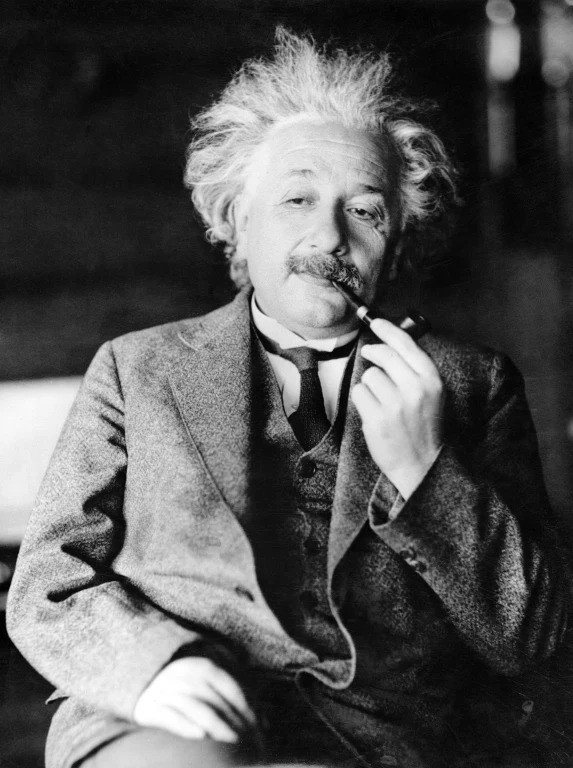Einstein’s Revolution: A Universe of Relative Space and Warped Time
Albert Einstein’s Theory of Relativity, composed of two interconnected frameworks, represents a monumental shift in scientific thought, fundamentally rewriting our understanding of space, time, and gravity. Published in 1905, Special Relativity describes the physics of motion in the absence of gravity, establishing the speed of light as a universal constant and revealing the intimate connection between space and time. A decade later, General Relativity expanded upon this, presenting a radical new vision of gravity not as a force, but as the curvature of a unified four-dimensional fabric called spacetime, shaped by the presence of mass and energy. [1][2] Together, these theories dismantled the 200-year-old Newtonian model of a static, absolute universe and introduced a dynamic cosmos where our measurements of reality are fundamentally relative. [1]
Special Relativity: The Fabric of Spacetime and the Cosmic Speed Limit
At the heart of Special Relativity lie two elegant, yet revolutionary, postulates. The first, the principle of relativity, extends Galileo’s observations to all laws of physics, stating they are identical for all observers in uniform, non-accelerating motion. [3][4] This means no experiment can determine one’s absolute motion; only motion relative to another frame of reference is meaningful. [5] The second, and more disruptive, postulate is the constancy of the speed of light in a vacuum, which remains the same for all observers, irrespective of their own velocity or the motion of the light source. [3][4] This directly contradicted classical mechanics, where velocities are simply additive. [2] To reconcile these two principles, Einstein was forced to abandon the long-held notion of absolute space and absolute time, instead unifying them into a single, four-dimensional continuum known as spacetime. [6][7]
The consequences of this unified spacetime are profound and defy everyday intuition. One major implication is time dilation: a clock in motion relative to an observer will be measured to tick slower than a stationary clock. [3][8] This is not a mechanical flaw but a fundamental property of time itself. A dramatic real-world verification of this is the constant decay rate of muons; these subatomic particles, created in the upper atmosphere and traveling at near-light speed, should decay long before reaching Earth’s surface based on their known lifespan at rest. [9][10] However, from our frame of reference, their internal clocks run so slowly that they survive the journey, providing direct evidence of time dilation. [9] Similarly, the theory predicts length contraction, where an object appears shorter in its direction of motion to a moving observer. [3][11] While difficult to observe directly, its effects are accounted for in particle accelerators, where the increased density of colliding heavy ions due to Lorentz contraction is a necessary consideration for experiments. [11] Perhaps the most famous outcome of Special Relativity is the mass-energy equivalence, encapsulated in the equation E=mc². This formula reveals that mass and energy are interchangeable forms of the same thing. [12][13] Because the speed of light (c) squared is an immense number, a minuscule amount of mass can be converted into a tremendous amount of energy, a principle that powers both nuclear reactors and the sun itself. [13][14]
General Relativity: Gravity as the Geometry of the Cosmos
Einstein’s 1915 masterpiece, General Relativity, addressed the major omission of his earlier work: gravity. It began with the equivalence principle, a thought experiment that established the indistinguishability between the effects of gravity and acceleration. [15][16] An observer in a windowless, accelerating rocket would feel the same force pinning them to the floor as an observer standing on Earth. [17] This insight led Einstein to a groundbreaking conclusion: gravity is not a force that propagates across space, but an intrinsic property of spacetime itself. [7][18] He proposed that mass and energy warp the fabric of spacetime, and the phenomenon we perceive as gravity is simply objects following the straightest possible paths—called geodesics—through this curved geometry. [18][19] As physicist John Wheeler summarized, “matter tells spacetime how to curve, and curved spacetime tells matter how to move.” [18]
The predictions stemming from this geometric theory of gravity have been repeatedly verified with stunning accuracy. One of the most striking is gravitational lensing, where the light from a distant object, such as a galaxy, is bent as it passes through the warped spacetime around a massive foreground object, like a galaxy cluster. [20][21] This can create distorted, magnified, or even multiple images of the background source, an effect now routinely used by astronomers with tools like the Hubble Space Telescope to observe galaxies that would otherwise be too faint and distant to see. [21][22] Another confirmed prediction is gravitational time dilation, which states that time passes more slowly in stronger gravitational fields. [23][24] This effect, though minuscule in our daily lives, is critical for the functionality of the Global Positioning System (GPS). [25][26] The atomic clocks on GPS satellites orbit in a weaker gravitational field than clocks on Earth’s surface, causing them to run faster by about 45 microseconds per day. [25] Combined with the 7-microsecond-per-day slowing predicted by Special Relativity due to their high velocity, a net correction of 38 microseconds is required. [25][27] Without continuously accounting for these relativistic effects, GPS navigation would accumulate errors of about 10 kilometers each day, rendering the system useless. [25][27] The theory also predicted the existence of gravitational waves—ripples in spacetime caused by cataclysmic cosmic events—which were directly detected for the first time in 2015, opening a new window to observing the universe. [17]



Leave your comment
You must be logged in to post a comment.